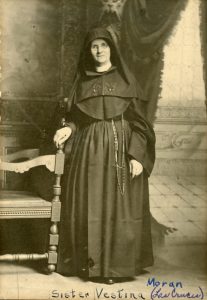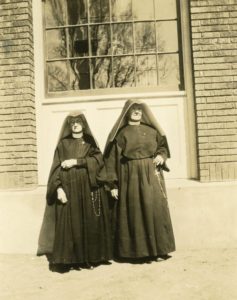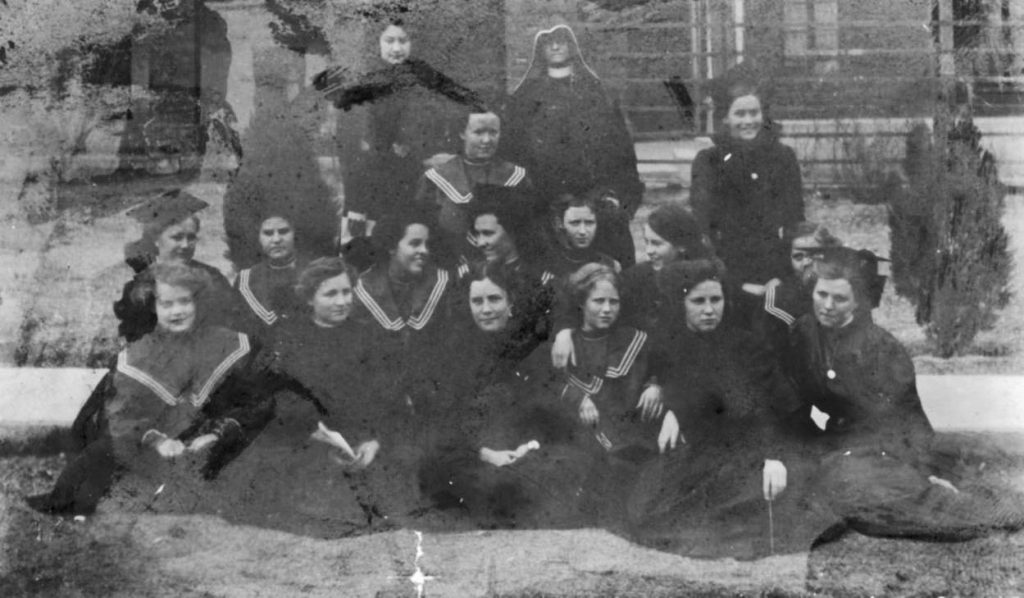Vestina Moran and the Stagecoach to Santa Fe
Posted on July 12, 2018, by Loretto Community
Adapted by Katie Santa Ana
The following story has been adapted from an unsigned account found in the personnel file of Sister Vestina Moran SL. While we can’t confirm all the facts, it’s certainly a fascinating read!

Sister M. Vestina – Mary Moran – was born in St. Louis in 1853, a daughter of Mr. Michael Moran and Ellen Brohan Moran, both Irish born and Catholic. In youth Sister Vestina attended the common schools and when the family moved to Edina, Missouri, she went four years to St. Joseph’s Academy there. Her sister Catherine, just younger than Sister, also became a Lorettine as Sister M. Adrian. Sister Vestina received the veil of a novice at Loretto, Kentucky, in 1868 at the age of fifteen, and after her profession she studied and taught just about every subject in the curriculum.
In 1870, just 17 years of age, she traveled West alone. Arriving in Denver, she learned that she must continue her journey to Santa Fe without a Sister companion. She cheerfully made the trip in a stagecoach and suffered untold hardships for weeks. After the first day or so, the other passengers were all men, intoxicated and fighting all the way. She made every effort to restore peace among them and succeeded in taking from them the revolvers they carried. These she kept until they had reached their destination. Unforeseen delay had drained her scant means until she had only 25 cents in her possession. She went without food and drink for three days. When she could endure it no longer, she bought a cup of coffee and had to pay 25 cents for it.

Another experience on this trip was told by Sister Vestina: when the stage left Denver there were several women passengers, but their destination was near Denver, so in a short time she was a lone woman among trappers, miners, cattlemen, hunters, etc. In the course of the trip they had to cross high passes in the mountains when the nights were extremely cold. Sister said the men camped at night, built a big camp fire to keep away wild animals and to keep warm, ate whatever food they had, wrapped themselves up in their blankets, and slept by the fire, leaving her the privacy of the stage coach. She appreciated this courtesy, western men were courteous in their own fashion, until they reached the high mountains, then the stagecoach was a mighty cold place. She wrapped herself up in all the clothes she had with her and still was cold.
One night she thought she would freeze to death, so she peeped out and scanned the faces of the men sleeping by the fire. One did not seem rough, but very kind and good, so climbing out of the coach she went over to him, awakened him and asked if she might share his blanket for she was freezing. Sleepily he rolled out of it and gave it to her saying he would roll in with his neighbor. Taking the blanket she returned to the coach and enjoyed a good night’s rest. Early next morning when the stage was being hitched up for the day’s journey, she looked for the noble-faced man to thank him for his kindness and to return the blanket. He was nowhere to be found. She inquired of the driver if anyone had left during the night and he said no one had. Sister never found any clue to her benefactor’s identity so she considered it a special gift from her good saint.
Upon reaching her destination Sister was stricken with a raging fever resulting from the strain and hardships she had endured on the four weeks’ trip from Denver to Santa Fe.
From Santa Fe she went to Las Cruces, thence to Mora where she spent two fruitful years until fire destroyed every earthly possession of the Sisters there. En route to Las Cruces, her next mission, she barely escaped drowning. A few days after her arrival as Superior, in Socorro, then a poor village with few inhabitants, and a small school, the town was shaken by an earthquake and the convent housed the people until they could rebuild their homes.
Sister Vestina celebrated her Golden Jubilee as a Lorettine in 1918, and the last seventeen years of her life were passed in historic Santa Fe. Of her in these last days of her sojourn on earth, one of the Loretto Sisters said: “A venerable figure indeed, a symbol of sacrifice still…The records of her career make her a shining light in the evangelization of the Southwest.” How true the prediction: “Generations shall pass where Lorettines fearlessly lead the way.”

